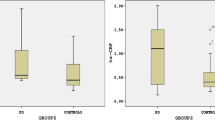Abstract
The role of carcinoembryonic antigen (CEA) in Parkinson’s disease (PD) has not been previously investigated. The aim of the present study was to evaluate the serum level of carcinoembryonic antigen, high-sensitivity C-reactive protein (hs-CRP), and Neutrophil/lymphocyte ratio (NLR) among patients with Parkinson’s disease and to examine the relationship between these inflammatory markers. The cross-sectional design includes 51 patients with Parkinson’s disease and 50 age- and sex-matched healthy controls. We investigated the differences in hs-CRP, CEA, and NLR levels between these two groups. CEA was significantly higher in PD patients relative to the control group (mean 2.40 ± 1.51 vs. 1.72 ± 0.87 (ng/mL), respectively; p = 0.015). Mean NLR was significantly higher in PD patients relative to the control group (mean 3.1 ± 1.3 vs. 2.1 ± 0.32, respectively; p < 0.001). Serum level of hs-CRP was higher in PD patients than in control group (mean 1.04 ± 0.62 and 0.54 ± 0.31, respectively; p < 0.01). Correlation analysis revealed significant correlation between hs-CRP, CEA, and Neutrophil/lymphocyte ratio (p < 0.05). This study demonstrates for the first time the association between CEA, hs-CRP, NLR, and PD. We found CEA, hs-CRP, and NLR levels to be significantly higher in the PD patients than in the normal controls.



Similar content being viewed by others
References
Tolosa E, Wenning G, Poewe W (2006) The diagnosis of Parkinson’s disease. Lancet Neurol 5:75–86
Hwang Onyou (2013) Role of oxidative stress in Parkinson’s disease. Exp Neurobiol 22(1):11–17
McGeer PL, Itagaki S, Boyes BE, McGeer EG (1988) Reactive microglia are positive for HLA-DR in the substantia nigra of Parkinson’s and Alzheimer’s disease brains. Neurology 38:1285–1291
Chen H, Zhang SM, Hernan MA, Schwarzschild MA, Willett WC et al (2003) Nonsteroidal anti-inflammatory drugs and the risk of Parkinson disease. Arch Neurol 60:1059–1064
Devos David, Lebouvier Thibaud, Lardeux Bernard, Biraud Mandy (2013) Colonic inflammation in Parkinson’s disease. Neurobiol Dis 50:42–48
Villaran RF, Espinosa-Oliva AM, Sarmiento M, De Pablos RM, Arguelles S et al (2010) Ulcerative colitis exacerbates lipopolysaccharide- induced damage to the nigral dopaminergic system: potential riskin Parkinson’s disease. J Neurochem 114:1687–1700
Shannon KM, Keshavarzian A, Mutlu E, Dodiya HB, Daian D, Jaglin JA, Kordower JH (2012) Alpha-synuclein in colonic submucosa in early untreated Parkinson’s disease. Mov Disord. doi:10.1002/mds.23828
Ruibal Morell A (1992) CEA serum levels in non-neoplastic disease. Int J Biol Markers 7:160–166
Ishizaka N, Ishizaka Y, Toda E, Koike K, Yamakado Nagai R (2008) Are serum carcinoembryonic antigen levels associated with carotid atherosclerosis in Japanese men? Arterioscler Thromb Vasc Biol 28(1):160–165
Szekanecz Eva, Sandor Zsuzsa, Anatalszalmas Peter (2007) Increased production of the soluble tumor-associated antigens CA19–9, CA125, and CA15–3 in Rheumatoid Arthritis. Potential adhesion molecules in synovial inflammation? Ann N Y Acad Sci 1408:359–371
Gokhan S, Ozhasenekler A, Mansur Durgun H, Akil E, Ustundag M, Orak M (2013) Neutrophil lymphocyte ratios in stroke subtypes and transient ischemic attack. Eur Rev Med Pharmacol Sci 17:653–657
Hughes AJ, Daniel SE, Kilford L, Lees AJ (1992) Accuracy of clinical diagnosis of idiopathic Parkinson’s disease. A clinico-pathological study of 100 cases. JNNP 55:181–184
Hoehn MM, Yahr MD (1967) Parkinsonism: onset, progression and mortality. Neurology 17:427–442
Koprich JB, Reske-Nielsen C, Mithal P, Isacson O (2008) Neuroinflammation mediated by IL-1beta increases susceptibility of dopamine neurons to degeneration in an animal model of Parkinson’s disease. J Neuroinflammation. doi:10.1186/1742-2094-5-8
Scalzo P, Kummer A, Cardoso F, Teixeira AL (2009) Increased serum levels of soluble tumor necrosis factor-α receptor-1 in patients with Parkinson’s disease. J Neuroimmunol 216(1–2):122–125
Song I-U, Kim Y-D, Cho H-J (2013) Is neuroinflammation involved in the development of dementia in patients with Parkinson’s disease? Intern Med 52:1787–1792
Mosley RL, Hutter-Saunders JA, Stone DK, Gendelman HE (2012) Inflammation and adaptive immunity in Parkinson’s disease. Cold Spring Harb Perspect Med 2(1):a009381
Benarroch EE (2007) Enteric nervous system: functional organization and neurologic implications. Neurology 69:1953–1957
Isaacson P (1976) Tissue demonstration of carcinoembryonic antigen (CEA) in ulcerative colitis. Gut 17:561–566
Cristina V, Lorenza P, Rudina N et al (2010) Carcinoembryonic antigen concentrations in patients with acute coronary syndrome. Clin Chem Lab Med 48(9):1339–1343
Bae U, Shim JY, Lee HR, Shin JY (2013) Serum carcinoembryonic antigen level is associated with arterial stiffness in healthy Korean adult Clinica. Chimica Acta 415:286–289
Ganguly A, Yeltsin E, Robbins J (2003) Identification of a carcinoembryonic antigen binding protein on monocytes. Biochem Biophys Res Commun 311:319–323
Aarons CB, Bajenova O, Andrews C, Heydrick S, Bushell KN, Reed KL et al (2007) Carcinoembryonic antigen-stimulated THP-1 macrophages activate endothelial cells and increase cell–cell adhesion of colorectal cancer cells. Clin Exp Metastasis 24:201–209
Alexiou D, Karayiannakis AJ, Syrigos KN, Zbar A, Kremmyda A, Bramis I (2001) Serum levels of E-selectin, ICAM-1 and VCAM-1 in colorectal cancer patients correlations with clinicopathological features, patient survival and tumour surgery. Eur J Cancer 37(18):2392–2397
Ozdemir Y, Akin ML, Sucullu I, Balta AZ, Yucel E (2014) Pretreatment neutrophil/lymphocyte ratio as a prognostic aid in colorectal cancer. Asian Pac J Cancer Prev 15(6):2647–2650
Mancinella A, Mancinella M, Carpinteri G et al (2009) Is there a relationship between high C-reactive protein (CRP) levels and dementia. Arch Gerontol Geriatr 49(Suppl 1):185–194
Acknowledgments
We are grateful to Dicle University DUBAP for their sponsorship about English editing of this manuscript.
Conflict of interest
None.
Author information
Authors and Affiliations
Corresponding author
Rights and permissions
About this article
Cite this article
Akıl, E., Bulut, A., Kaplan, İ. et al. The increase of carcinoembryonic antigen (CEA), high-sensitivity C-reactive protein, and neutrophil/lymphocyte ratio in Parkinson’s disease. Neurol Sci 36, 423–428 (2015). https://doi.org/10.1007/s10072-014-1976-1
Received:
Accepted:
Published:
Issue Date:
DOI: https://doi.org/10.1007/s10072-014-1976-1




